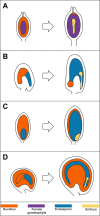Seed tissue and nutrient partitioning, a case for the nucellus
- PMID: 29869727
- PMCID: PMC6105262
- DOI: 10.1007/s00497-018-0338-1
Seed tissue and nutrient partitioning, a case for the nucellus
Abstract
Flowering plants display a large spectrum of seed architectures. The volume ratio of maternal versus zygotic seed tissues changes considerably among species and underlies different nutrient-storing strategies. Such diversity arose through the evolution of cell elimination programs that regulate the relative growth of one tissue over another to become the major storage compartment. The elimination of the nucellus maternal tissue is regulated by developmental programs that marked the origin of angiosperms and outlined the most ancient seed architectures. This review focuses on such a defining mechanism for seed evolution and discusses the role of nucellus development in seed tissues and nutrient partitioning at the light of novel discoveries on its molecular regulation.
Keywords: Endosperm; Nucellus; Ovule; Partitioning; Perisperm; Seed.
Figures


References
-
- Arekal GD, Nagendran CR. Is there a Podostcmum type of embryo sac in the genus Farmeria? Caryologia. 1975;28:229–235. doi: 10.1080/00087114.1975.10796613. - DOI
-
- Arekal GD, Nagendran CR. The female gametophyte in two Indian genera of Tristichoideae (Podostemaceae)—A reinvestigation. Proc Indian Acad Sci. 1977;86:287–294.
-
- Bagnall N, Wang X-D, Scofield GN, Furbank RT, Offler CE, Patrick JW. Sucrose transport-related genes are expressed in both maternal and filial tissues of developing wheat seeds. Aust J Plant Physiol. 2000;27:1009–1020.
Publication types
MeSH terms
Grants and funding
LinkOut - more resources
Full Text Sources
Other Literature Sources

